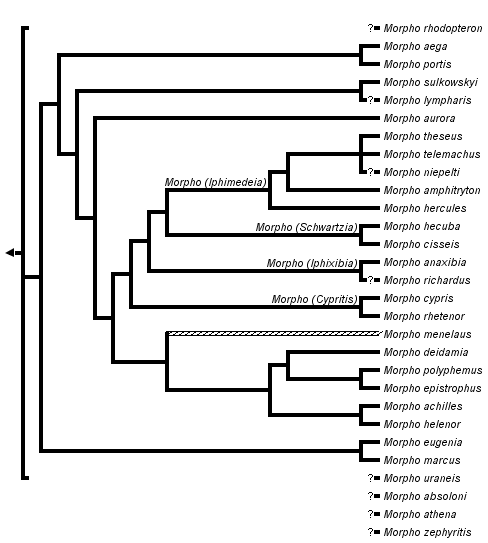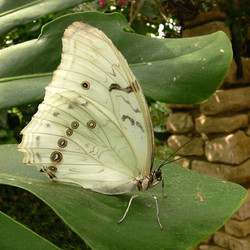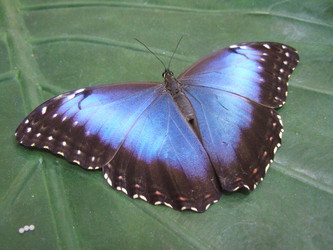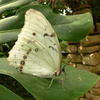Morpho
Andrew V. Z. Brower


This tree diagram shows the relationships between several groups of organisms.
The root of the current tree connects the organisms featured in this tree to their containing group and the rest of the Tree of Life. The basal branching point in the tree represents the ancestor of the other groups in the tree. This ancestor diversified over time into several descendent subgroups, which are represented as internal nodes and terminal taxa to the right.

You can click on the root to travel down the Tree of Life all the way to the root of all Life, and you can click on the names of descendent subgroups to travel up the Tree of Life all the way to individual species.
For more information on ToL tree formatting, please see Interpreting the Tree or Classification. To learn more about phylogenetic trees, please visit our Phylogenetic Biology pages.
close boxIntroduction
The "blue morpho butterflies" represent one of the best known and most spectacular genera of Nymphalidae. They are mostly large - some with wingspans up to 20 cm, and many species have iridescent scales that reflect a metallic blue color. The blue color is due to refraction of light by fine striations on the surfaces of the wing scales - there is no blue pigment. The undersides of most species are brown with a variety of eye spots and smaller ocelli - features that reveal their affinity with other satyrines.
The classic living Morpho experience is to observe males patrolling along forest trails and stream beds appearing as a series of metallic blue flashes as the sun catches their wings. Collectors often equip themselves with a card covered with blue aluminum foil to attract the attention of males, who may swoop in to defend their territory against the incursion of a perceived interloper.
While the most familiar species are large and blue, there is quite a range of diversity in the genus (which has led to the description of numerous subgenera). Some Morpho species (M. epistrophus, M. polyphemus) are white, others are dark brownish gray or tawny orange (M. hecuba, M. telemachus). Some Andean species are smaller and quite delicate (M. lympharis).
Unlike most other satyrine taxa, some Morpho larvae feed on dicots. Penz and DeVries (2002) note that this larval host switch appears to have occurred once within the genus, the more basal species retaining the ancestral monocot diet.
Discussion of Phylogenetic Relationships
The phylogenetic hypothesis is based upon Penz & DeVries (2002) morphological cladogram, with updates of nomenclature from Lamas (2004). Non-monotypic subgenera that appear as monophyletic taxa in the cladogram are labelled. However, as Penz and Devries noted, the polyphyly of many other subgenera suggests that until the systematics of the genus is better understood, perhaps these names should be avoided.
Nomenclature
The genus Morpho has been subject of an enormous quantity of taxonomic revisionary work at the generic/subgeneric and specific/subspecific levels. The nomenclature employed here is based on the recent checklist of Lamas (2004), which adopts a relatively conservative view, including all the species within a single genus, and synonymizing many variations/geographical races under a relatively limited number of species. There are considerable differences in the nomenclature employed by Lamas vs. Penz & DeVries. Andy Brower is responsible for any errors of cross-referencing of the names on this tree.
Other Names for Morpho
- Potamis
- Brassolis
- Megamede
- Leonte
- Heliornis
- Iphimedeia
- Iphixibia
- Cytheritis
- Zeuxidion
- Balachowskyna
- Cypritis
- Pessonia
- Grasseia
- Schwartzia
References
Lamas G ed. 2004. Atlas of Neoptropical Lepidoptera. Checklist: Part 4A Hesperioidea - Papiionoidea. Gainesville: Scientific Publishers/Association of Tropical Lepidoptera.
Le Moult E, and Real P. 1962. Les Morpho d'Amérique du Sud et Centrale. Editions scientifiques du Cabinet entomologique E. Le Moult, Paris.
Penz CM, and DeVries PJ. 2002. Phylogenetic analysis of Morpho butterfles (Nymphalidae, Morphinae): implications for classification and natural history. Amer. Mus. Novitates 3374: 1-33.
Title Illustrations

| Scientific Name | Morpho polyphemus |
|---|---|
| Location | captive at Stratford Butterfly Farm |
| Specimen Condition | Live Specimen |
| Source | Morpho polyphemus 3 |
| Source Collection | Flickr |
| Image Use |
 This media file is licensed under the Creative Commons Attribution-NonCommercial-ShareAlike License - Version 2.0. This media file is licensed under the Creative Commons Attribution-NonCommercial-ShareAlike License - Version 2.0.
|
| Copyright | © 2006 Walwyn |
| Scientific Name | Morpho menelaus |
|---|---|
| Location | captive at Pacific Science Center, Seattle, Washington, USA |
| Specimen Condition | Live Specimen |
| Source | egg hunt |
| Source Collection | Flickr |
| Image Use |
 This media file is licensed under the Creative Commons Attribution-NonCommercial-NoDerivs License - Version 2.0. This media file is licensed under the Creative Commons Attribution-NonCommercial-NoDerivs License - Version 2.0.
|
| Copyright | © 2006 Tamara Weikel |
About This Page

Middle Tennessee State University, Murfreesboro, Tennessee, USA
Correspondence regarding this page should be directed to Andrew V. Z. Brower at
Page copyright © 2010
 Page: Tree of Life
Morpho .
Authored by
Andrew V. Z. Brower.
The TEXT of this page is licensed under the
Creative Commons Attribution License - Version 3.0. Note that images and other media
featured on this page are each governed by their own license, and they may or may not be available
for reuse. Click on an image or a media link to access the media data window, which provides the
relevant licensing information. For the general terms and conditions of ToL material reuse and
redistribution, please see the Tree of Life Copyright
Policies.
Page: Tree of Life
Morpho .
Authored by
Andrew V. Z. Brower.
The TEXT of this page is licensed under the
Creative Commons Attribution License - Version 3.0. Note that images and other media
featured on this page are each governed by their own license, and they may or may not be available
for reuse. Click on an image or a media link to access the media data window, which provides the
relevant licensing information. For the general terms and conditions of ToL material reuse and
redistribution, please see the Tree of Life Copyright
Policies.
- First online 29 October 2006
- Content changed 12 February 2010
Citing this page:
Brower, Andrew V. Z. 2010. Morpho . Version 12 February 2010 (under construction). http://tolweb.org/Morpho/70770/2010.02.12 in The Tree of Life Web Project, http://tolweb.org/









 Go to quick links
Go to quick search
Go to navigation for this section of the ToL site
Go to detailed links for the ToL site
Go to quick links
Go to quick search
Go to navigation for this section of the ToL site
Go to detailed links for the ToL site